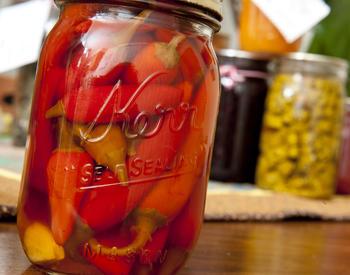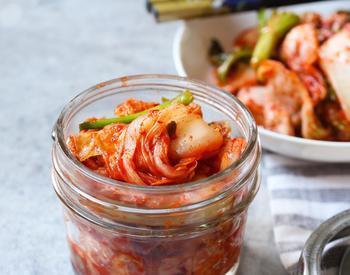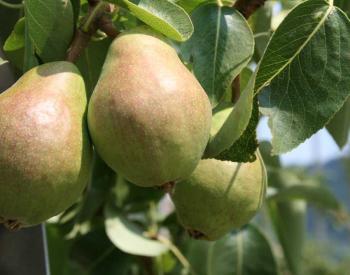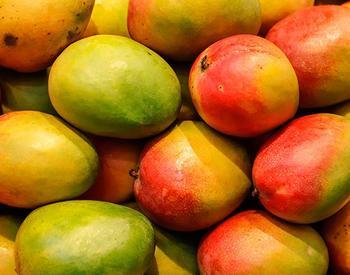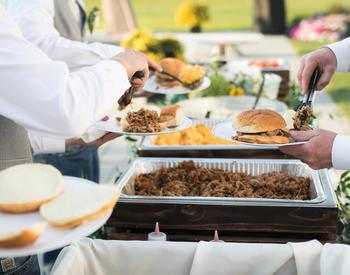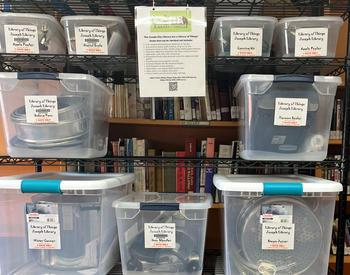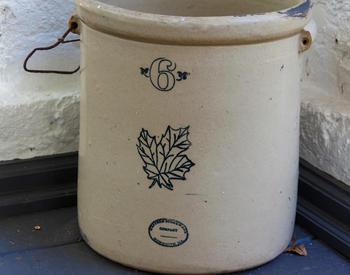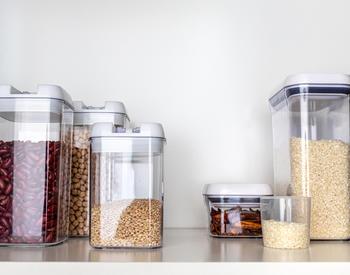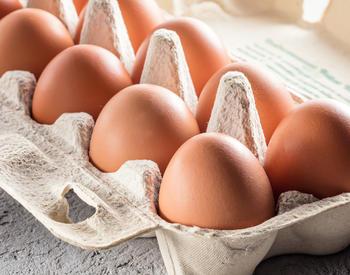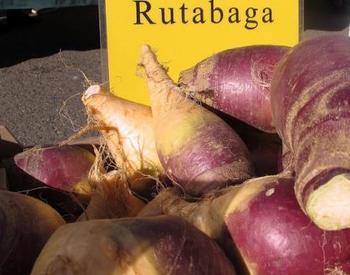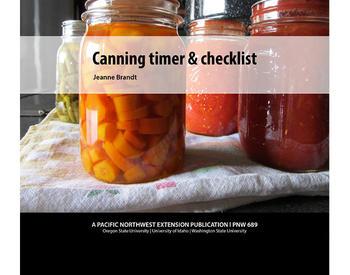Download this publication as a PDF
Fruit pickles are usually prepared from whole fruits and simmered in a spicy, sweet-and-sour syrup. Pickled fruits are an ideal accompaniment for meat, poultry and fish entrees.
Chutney is a fruit relish made from chunks of fruits and/or vegetables and nuts cooked in a sweet-and-sour blend of herbs, spices, sugar and vinegar. Chutney is served as a condiment with foods such as meats, poultry and sandwiches.
Ingredients
- Fruit — Select slightly underripe fruit. (Underripe fruit will retain its shape and texture better after pickling.) Fruit is usually pickled whole or halved. Select uniform-size pieces for each jar. Fruits suitable for pickling include apples, crab apples, peaches, pears, figs, plums and watermelon rind. Smaller fruit such as blueberries, seedless grapes and gooseberries can also be pickled.
- Vinegar — Use a high-grade cider or white distilled vinegar of 5% or 50 grain acidity. Cider vinegar has a mellow acidic taste but may darken light-colored fruits. White distilled vinegar has a sharp, pungent, acidic taste and is recommended for light-colored fruits. Do not dilute the vinegar unless specified in the recipe.
- Spices — Because ground spices will change the color of the fruit pickle, whole spices are better. Spices are usually cooked in the brine and then removed before the pickles are processed. You can vary the spices you add. Ground spices can be used in chutney recipes and are usually not removed before canning.
- Sugar — You can use either white granulated or brown sugar in pickle recipes. Brown sugar should not be used with light-colored fruits.
Preparation and storage
Follow preparation instructions. For long-term storage, process in a boiling water canner as directed. After the jars have cooled and sealed, remove screwbands and wash jars. Store in a cool, dry, dark place.
Fruit pickles and chutney can also be refrigerated for short-term storage.
References: "So Easy to Preserve", 5th ed. 2006. Bulletin 989, Cooperative Extension Service, The University of Georgia, Athens. Revised by Elizabeth L. Andress. Ph.D. and Judy A. Harrison, Ph.D
Fruit pickle recipes
Spiced Crabapples (Yield: about 9 pints)
- 5 lbs. crabapples
- 4½ cups apple cider vinegar (5%)
- 3¾ cups water
- 7½ cups sugar
- 4 tsp whole cloves
- 4 sticks cinnamon
- Six ½-inch cubes of fresh ginger root
Procedure:
- Remove blossom petals and wash apples, but leave stems attached.
- Puncture the skin of each apple four times with an ice pick or toothpick.
- Mix vinegar, water, and sugar and bring to a boil.
- Add spices tied in a spice bag or cheesecloth.
- Using a blancher basket or sieve, immerse 1/3 of the apples at a time in the boiling vinegar/syrup solution for 2 minutes.
- Place cooked apples and spice bag in a clean 1- or 2-gallon crock and add hot syrup.
- Cover and let stand overnight.
- Remove spice bag, drain syrup into a large saucepan, and reheat to boiling
- Fill pint jars with apples and hot syrup, leaving 1/2-inch headspace.
- Adjust lids and process according to the recommendations below:
|
Table 1. Recommended process time for Spiced Crabapples in a boiling-water canner. |
|||||
|
|
Process time at altitudes of: |
||||
|
Style of pack |
Jar size |
0–1,000 ft |
1,001–3,000 ft |
3,001–6,000 ft |
Above 6,000 ft |
|
Hot |
Pints |
|
|
|
|
After processing, take canner off heat. Remove lid. Wait 5 minutes before removing jars.
Peach Pickles (Yield: about 3 quarts)
- 8 pounds peeled peaches, small- to medium-sized
- 6¾ cups sugar
- 4 sticks cinnamon
- 2 tablespoons whole cloves, crushed
- 1 tablespoon ground ginger
- 1 quart vinegar (5%)
Procedure:
- Wash and peel peaches. Treat to prevent darkening.
- Dissolve sugar in vinegar in large sauce pot and heat. Boil 5 minutes and skim.
- Add spices tied in a cheesecloth bag.
- Drop drained peaches into boiling syrup and cook until they can be pierced with a fork, but not soft.
- Remove from heat and allow peaches to sit in pickling liquid overnight to plump.
- Return to stove and bring to a boil.
- Pack peaches into hot jars, leaving ¼ inch headspace.
- Pour hot liquid over peaches, leaving ¼ inch headspace. Remove air bubbles. Adjust caps.
- Process 20 minutes in boiling water bath.
After processing, take canner off heat. Remove lid. Wait 5 minutes before removing jars.
Fig Pickles (Yield: about 8 pints)
- 4 quarts firm-ripe figs
- 3 cups sugar
- 2 quarts water
- 2 cups sugar
- 3 cups vinegar
- 2 sticks cinnamon
- 1 tablespoon whole allspice
- 1 tablespoon whole cloves
Procedure:
- Peel figs. (If unpeeled are preferred, pour boiling water over figs and let stand until cool; drain.)
- Add 3 cups sugar to water and cook until sugar dissolves.
- Add figs and cook slowly 30 minutes.
- Add 2 cups sugar and vinegar.
- Tie spices in a cheesecloth bag; add to figs.
- Cook gently until figs are clear. Cover and let stand 12 to 24 hours in refrigerator.
- Remove spice bag and heat figs in brine to the boiling point.
- Fill hot figs and brine into clean, hot jars, leaving ½-inch head space.
- Remove air bubbles and adjust headspace if needed.
- Wipe rims of jars with a dampened clean paper towel; adjust two-piece metal canning lids. Process in a boiling water canner according to recommendations below.
Table 2. Recommended process time for Fig Pickles in a boiling-water canner.
Process time at altitudes of
Style of Pack
Jar Size
0–1,000 ft
1,001–3,000 ft
3,001–6,000 ft
Above 6,000 ft
Hot
Pints
15 min
20
20
20
After processing, take canner off heat. Remove lid. Wait 5 minutes before removing jars.
Watermelon Rind Pickles (Yield: about 4 or 5 pints)
- 3 quarts (about 6 pounds) watermelon rind, unpared
- ¾ cup salt
- 3 quarts water
- 2 quarts (2 trays) ice cubes
- 9 cups sugar
- 3 cups 5% vinegar, white
- 3 cups water
- 1 tablespoon (about 48) whole cloves
- 6 cinnamon sticks, 1 inch pieces
- 1 lemon, thinly sliced, with seeds removed
Procedure:
- Trim the pink flesh and outer green skin from thick watermelon rind.
- Cut into 1-inch squares or fancy shapes as desired.
- Cover with brine made by mixing the salt with 3 quarts cold water.
- Add ice cubes. Let stand 3 to 4 hours.
- Drain; rinse in cold water.
- Cover with cold water and cook until fork tender, about 10 minutes (do not overcook). Drain.
- Combine sugar, vinegar, water, and spices (tied in a clean, thin, white cloth).
- Boil 5 minutes and pour over the watermelon; add lemon slices. Let stand overnight in the refrigerator.
- Heat watermelon in syrup to boiling and cook slowly 1 hour.
- Pack hot pickles loosely into clean, hot pint jars.
- To each jar add 1 piece of stick cinnamon from spice bag; cover with boiling syrup, leaving ½ inch headspace. Remove air bubbles and adjust headspace if needed.
- Wipe rims of jars with a dampened clean paper towel; adjust two-piece metal canning lids. Process according to the recommendations below. Let cool, undisturbed, 12-24 hours and check for seals.
|
Table 3. Recommended process time for Watermelon Rind Pickles in a boiling-water canner. |
||||
|
|
Process time at altitudes of |
|||
|
Style of pack |
Jar size |
0–1,000 ft |
1,001–6,000 ft |
Above 6,000 ft |
|
Hot |
Pints |
10 min |
15 |
20 |
After processing, take canner off heat. Remove lid. Wait 5 minutes before removing jars.
Pear Pickles (Yield: About 7 or 8 pint jars)
- 2 quarts (8 cups) sugar
- 1 quart (4 cups) white vinegar (5%)
- 1 pint (2 cups) water
- 8 cinnamon sticks (2-inch pieces)
- 2 tablespoons whole cloves
- 2 tablespoons whole allspice
- 8 pounds (4–5 quarts) Seckel pears or other pickling pear
Procedure:
- Combine sugar, vinegar, water and cinnamon sticks; add cloves and allspice tied in a clean, thin, white cloth.
- Bring mixture to a boil and simmer, covered, about 30 minutes.
- Wash pears, remove skins, and all of blossom end; the stems may be left on if desired. If pears are large, halve or quarter.
- To prevent peeled pears from darkening during preparation, immediately after peeling, put them into a cold solution containing ½ teaspoon ascorbic acid per 2 quarts water.
- Drain pears just before using.
- Add drained pears to the hot syrup. Bring to a boil. Lower heat and continue simmering for another 20 to 25 minutes.
- Pack hot pears into hot pint jars; add one 2-inch piece cinnamon stick per jar.
- Cover pears with boiling syrup, leaving ½-inch headspace and making sure pears are covered by the syrup. Remove air bubbles and adjust headspace if needed.
- Wipe rims of jars with a dampened clean paper towel; adjust two-piece metal canning lids. Process according to the recommendations below.
|
|||||
|
|
|
||||
|
Style of pack |
Jar size |
0–1,000 ft |
1,001–3,000 ft |
3,001–6,000 ft |
Above 6,000 ft |
|
Hot |
Pints |
20 min |
25 |
30 |
35 |
After processing, take canner off heat. Remove lid. Wait 5 minutes before removing jars.
Chutney recipes
Peach or Pear Chutney (Yield: about 7 pints)
- 4 quarts finely chopped, peeled peaches or pears (about 20 medium)
- 1 cup raisins
- 1 cup chopped onions (about 1 medium)
- 2 to 3 cups brown sugar
- 5 cups vinegar
- 1/4 cup mustard seed
- 2 tablespoons ginger
- 2 teaspoons salt
- 1 clove garlic, minced (optional)
- 1 hot red pepper
Procedure:
- Combine all ingredients in a large sauce pot.
- Cook slowly until thick, about 40 minutes.
- Stir frequently to prevent sticking.
- Pour hot into hot jars, leaving 1/2 inch headspace. Adjust caps.
- Process 10 minutes in boiling water bath.
- After processing, take canner off heat. Remove lid. Wait 5 minutes before removing jars.
Note: For a milder chutney, remove seeds from hot pepper. Use rubber gloves to prevent burning hands.
Tomato Apple Chutney (Yield: about 6 pints)
- 2½ quarts peeled, cored, chopped ripe tomatoes (about 15 large)
- 1 quart chopped, cored, pared apples (about 5 medium)
- 2 cups chopped cucumber (about 1 large)
- 1½ cups chopped onion (about 1½ medium)
- 1½ cups chopped sweet red peppers (about 2 medium)
- 1 cup raisins
- 3 cups brown sugar
- 1 hot red pepper
- 1 clove garlic, crushed
- 1 tsp. salt
- 1 tablespoon ginger
- 1 teaspoon cinnamon
- 3 cups vinegar
Procedure:
- Combine all ingredients in a large sauce pot.
- Cook slowly until thick, about 1½ to 2 hours.
- As mixture thickens, stir frequently to prevent sticking.
- Pour hot into hot jars, leaving ¼ inch headspace. Adjust caps.
- Process 10 minutes in boiling water bath.
- After processing, take canner off heat. Remove lid.
- Wait 5 minutes before removing jars.
Apple Chutney (Yield: about 10 pints)
- 2 quarts chopped, cored, pared, tart apples (about 16 medium)
- 2 pounds raisins
- 1 cup chopped onions (about 1 medium)
- 1 cup chopped sweet red peppers (about 2 medium)
- 4 cups brown sugar
- 3 tablespoons mustard seed
- 2 tablespoons ginger
- 2 teaspoons allspice
- 2 teaspoons salt
- 2 hot red peppers
- 1 clove garlic, crushed
- 1 quart vinegar
Procedure:
- Combine all ingredients in a large sauce pot.
- Simmer until thick, about 1 hour and 15 minutes. As mixture thickens, stir frequently to prevent sticking.
- Pour hot into hot jars, leaving ¼ inch headspace. Adjust caps.
- Process 10 minutes in boiling water bath.
- After processing, take canner off heat. Remove lid. Wait 5 minutes before removing jars.
NOTE: For a milder chutney, another quart of chopped apples may be added.
Mango Chutney (Yield: about 6 pint jars)
- 11 cups or 4 pounds chopped unripe (hard) mango, either Tommy Atkins or Kent varieties (about 9 to 10 large whole mangoes, or 6 pounds, as purchased)
- 2½ cups or ¾ pound finely chopped yellow onion (about 1 pound onions as purchased)
- 2½ tablespoons grated fresh ginger
- 1½ tablespoons finely chopped fresh garlic
- 4½ cups sugar
- 3 cups white distilled vinegar (5%)
- 2½ cups golden raisins
- 1½ teaspoon canning salt
- 4 teaspoons chili powder
Caution: Handling green mangoes may irritate the skin of some people in the same way as poison ivy. (They belong to the same plant family.) To avoid this reaction, wear plastic or rubber gloves while working with raw green mango. Do not touch your face, lips or eyes after touching or cutting raw green mangoes until all traces are washed away.
Procedure:
- Wash and rinse pint or half-pint canning jars; keep hot until ready to use. Prepare lids according to manufacturer's directions.
- Wash all produce well. Peel, core and chop mangoes into ¾-inch cubes. Chop mango cubes in food processor, using 6 one-second pulses per food processor batch. (Do not puree or chop too finely.) By hand, peel and dice onion, finely chop garlic, and grate ginger.
- Mix sugar and vinegar in an 8- to 10-quart stockpot. Bring to a boil and boil 5 minutes. Add all other ingredients and bring back to a boil. Reduce heat and simmer 25 minutes, stirring occasionally.
- Fill hot chutney into clean, hot pint or half-pint jars, leaving ½-inch headspace. Remove air bubbles and adjust headspace if needed. Wipe rims of jars with a dampened, clean paper towel; adjust two-piece metal canning lids.
- Process in a boiling water canner according for 10 minutes (15 minutes at altitudes over 1,000 feet). Let cool, undisturbed, for 12 to 24 hours and check for seals.
Source: OSU Master Food Preservers Program
References: "So Easy to Preserve," 5th ed. 2006. Bulletin 989, Cooperative Extension Service, The University of Georgia, Athens. Revised by Elizabeth L. Andress. Ph.D. and Judy A. Harrison, Ph.D
2017 Oregon State University. OSU Extension Service cooperating. OSU Extension Service offers educational programs, activities, and materials without discrimination based on race, color, religion, sex, sexual orientation, national origin, age, marital status, disability, or disabled veteran or Vietnam-era veteran status. OSU Extension Service is an Equal Opportunity Employer.
